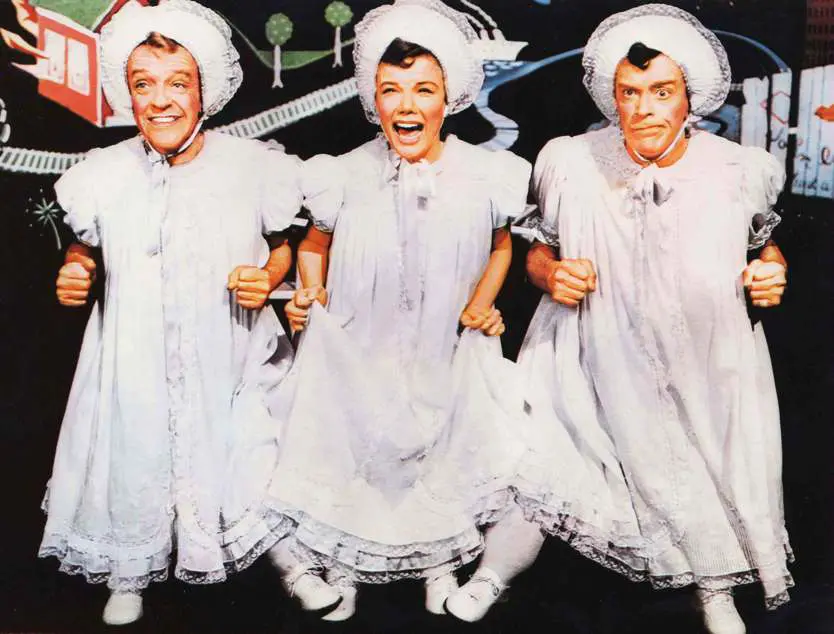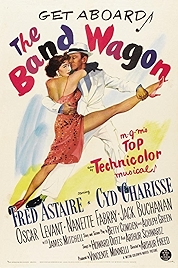A movie for every day of the year – a good one
3 May
Betty Comden born, 1917
On this day in 1917, lyricist, librettist and screenwriter Betty Comden was born, as Basya Cohen, in Brooklyn, New York. After finishing high school she studied drama at New York University, where she formed a small revue troupe with Judy Holliday, Leonard Bernstein and Adolph Green. Green would go on to be her lifelong writing partner. Being performers and writers, both Comden and Green liked to write themselves into their works. Which is what they did with On the Town, their first big Broadway success. After a couple of flop shows, the duo headed to Hollywood, where they wrote the screenplays for the Astaire Rogers vehicle The Barkleys of Broadway. They then adapted On the Town for Gene Kelly and Frank Sinatra, before following up three years later with 1952’s Singin’ in the Rain. This was followed the next year by The Band Wagon, which included fictionalised versions of themselves as the writers of a stage show that will be the comeback for ageing hoofer Tony Hunter (Fred Astaire). Comden and Green moved back to Broadway in the late 1950s and continued producing shows up until 1991. She won seven Tonys but no Oscars, in spite of having worked on two of the most iconic musicals of all time.
The Band Wagon (1953, dir: Vincente Minnelli)
The Band Wagon is a classic of the “let’s do the show right here” style of backstage musical comedy. It’s also a classic “art based on life” story – as its predecessor Singin’ in the Rain had been – about a washed up dancer giving it one last hoof before the curtain falls.
Fred Astaire plays the dancer, and in the opening scene we see an old top hat and cane being sold at some celebrity memorabilia auction. Except nobody wants to buy. Astaire was 54 at the time of The Band Wagon and though he’d live nearly another 35 years, this really was his big last hurrah.
Art again mirrors life in the pairing of vaudevillian Astaire with sleek, young, classically trained Cyd Charisse, playing the sleek, young, classically trained dancer Fred’s Tony Hunter is nervous about being paired with. We get to the “let’s do the show right here” bit after Jack Buchanan, as the up-himself artistic director, has ruined this pairing by drenching his latest show in European high culture – he fancies it as a reworking of Faust – before Lester and Lily Marton (Oscar Levant and Nanette Fabray as lightly fictionalised versions of Comden and Green) pull the baby out of the fire at the last minute, chucking out all the old, stiff, European nonsense and injecting lots of brash, bright American chutzpah.
Never mind that the songs are actually for the most part old ones, and never mind the plot, or much of the dialogue, which is as corny as hell, or the chemistry between Astaire and Charisse, which is fine while they’re dancing, uneasy while they’re not. The brilliance of The Band Wagon lies in the staging of the musical numbers, the way director and former window dresser Vincente Minnelli controls colour and movement. And the songs themselves. This is the film that gave us That’s Entertainment. And Triplets (“If one of us gets the measles/Another one gets the measles…”). And You and the Night and the Music. And Dancing in the Dark. There are around 20 musical numbers, in fact, coming at you at about one every ten minutes.
Jack Buchanan, a voice like a sea lion, manages to steal the film from Astaire. Or maybe it’s fairer to say that Astaire lets him have it. This is in any case a very democratic affair, as Singin’ in the Rain was, with everyone getting their moment to shine. And don’t they.
Why Watch?
- One of the best musicals ever made
- Any opportunity to watch Fred Astaire should be seized
- The lush Technicolor cinematography
- The sets for the Girl Hunt sequence
The Band Wagon – at Amazon
I am an Amazon affiliate
© Steve Morrissey 2014

